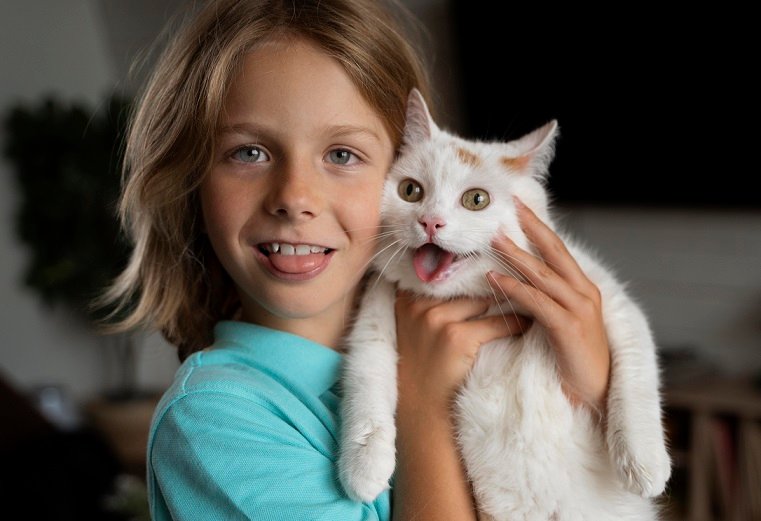Did your child talk you into bringing home a pet and then stop caring for the animal? Unfortunately, this is a story that we’ve heard way too many times. Your children long for a pet and convince you that caring for the animal will teach them lessons like responsibility. After bringing home the pet, there’s a “honeymoon period” where the children are fantastic. They are diligent about caring for the animal, monitoring things such as:
- Food
- Water
- Exercise
- Grooming

But then, after a few months, things begin to change. Perhaps your child has become acclimated with the pet in the household and forgets how much hard work is needed to provide an excellent quality of life. Or, maybe your children realize how challenging it is to care for a pet and refuse to do so. Now what? Below, you’ll find some tips and pointers to help motivate your children to look after their pets.
Start Small
If your children would like to bring home a dog, cat, or other exotic pet, but you’re worried about how motivated they’ll be to care for the animal, consider starting on a smaller scale. Explain to your children that caring for one of these animals requires a lot of work and is a tremendous commitment. Then, compromise with your children and let them know that if they can care for a smaller animal first, then you’ll consider another pet. Consider small pets such as:
- Fish
- Hamsters
- Gerbils
- Guinea Pigs
Set An Example
When bringing a pet into your home, it’s imperative that adults set an example for kids. If adults are gentle and kind with the new pet, children will be as well. On the other hand, if adults neglect or ignore the pet and treat it poorly, children will follow suit in this direction as well. Parents should instill a sense of love and respect toward the animal, which should help motivate children to care for the pet.

This is a significant mistake that many parents make when talked into getting a pet. Many parents tell their children something along the lines of, “It’s your pet, you need to take care of it.” However, children love to learn by example and often don’t know how they should be caring for their new pet. If a parent “takes the reins” and can demonstrate how to care for the new pet properly, kids will be following in their footsteps in no time.
Create A “Chores List”
If you find that your children are arguing about over who’s turn it is to walk the dog, consider creating a chores list or pet roster. This list will allocate specific tasks to each of your children. However, we recommend that you do this with the input of your children. Otherwise, it will seem disciplinary. They’ll begin to care for their pet because they have to, not because they want to.
Sit down with your children and talk about what they want to be held responsible for. Perhaps consider a system where a child receives a gold star for each task completed successfully. The child with the most gold stars at the end of the week or month gets a prize. Instilling friendly competition between children is an excellent way to help ensure the pet receives the care it deserves.
Be Reasonable
You should also be mindful of how old your children are when setting these responsibilities. For instance, a teenager can take the dog for a walk around the block, while a five-year-old likely cannot. On the other hand, a toddler can pick up your pet’s toys easily. Try to come up with responsibilities that are age-appropriate.
Similarly, parents should be reasonable when allocating responsibilities for their children. No parent should bring a pet into the home with the expectation that their children will care for the animal entirely. Parents should know that they are still going to need to care for the animal, no matter how much their children are willing to help. When it comes to caring for a pet, parents should expect their child to help with one or two chores.

Lastly, parents must accept that sometimes children’s lack of motivation comes from frustration and failure. Parents shouldn’t be afraid to post reminders that diagram how to complete a specific chore with tips to do so. This can help ensure that children learn each step necessary to complete a task correctly. It requires a bit of work upfront from parents but can help cut down on future problems considerably.
Try Not To Nag
Owning a pet should be an enjoyable experience. If you are struggling to keep your children motivated to care for their pet, consider coming up with another new and exciting game or method. However, parents should not resort to nagging or begging. Owning a pet should be a fun experience. Having to nag or yell at your children takes away from this significantly.
Instead of nagging, praise your children and promote positive thinking. While complimenting your child, don’t be afraid to correct one or two steps. An example: “Thanks for cleaning up the dog’s toys. I’m really glad to see you caring for her. Remember to put the lid on the bin when you’re done cleaning up.”
Parents can also consider using empathy for the pet as a method to motivate their children. For instance, MEd Jan Faull provides an example to Parents.com, saying, “Poor kitty’s hungry. She can’t fix her own breakfast. Her tummy is probably growling.” Creating compassion for others is an excellent life lesson to instill in your children.
What Methods Have You Used To Motivate Your Children?
Have you ever struggled to motivate your children to watch after their pets? If so, what methods did you use to encourage responsibility? We want to hear from you! Feel free to share your experiences in the comment section below. We love feedback from our readers, and we hope that we can foster dialogue among pet parents (or those expecting)! We look forward to hearing about your personal experiences soon.

